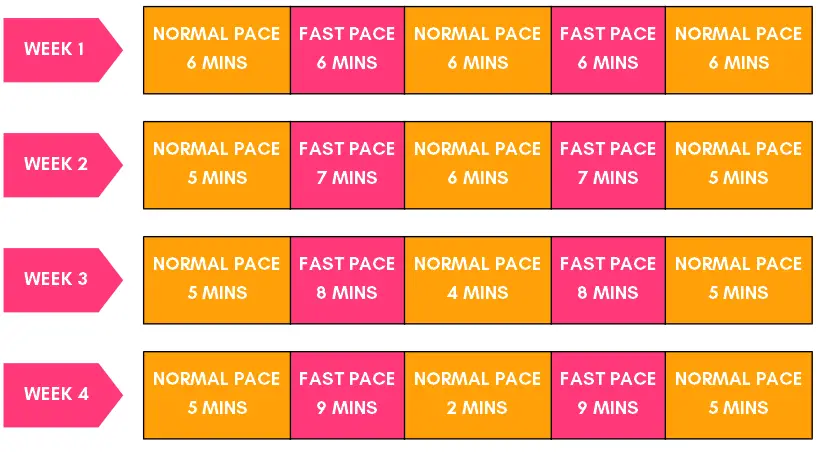Walking has many benefits for health and fitness, but one of the main reasons for people wanting to take up a walking program is to lose weight. It’s an easy way to burn more calories, because it’s a normal every day activity that you don’t need any special equipment or preparation for. You just need to allow a bit of time in your daily schedule. To maximise calorie burning, this 8 week walking plan for weight loss combines normal walking speed and fast walking speed. It’s based on doing a 30 minute walk 6 days a week.
8 week walking plan for weight loss – the schedule
The schedule includes 2 walking speeds – normal and fast walking. Normal walking speed is just how you would usually walk. For most people this is around 3mph. Fast walking is a speed that makes you feel warm and a little out of breath – for most people this will be around 4mph. If your walking speeds are slower, that’s not a problem. It means you won’t burn quite so many calories over the 8 weeks, but you’ll still lose weight and improve your fitness.
Weeks 1-4 schedules
For the first 4 weeks the time spent fast walking gradually increases, while the normal speed recovery interval decreases.

Weeks 5-8 schedule
The schedule stays the same for the second half of the program – 20 minutes of fast walking with 5 minutes warm up & cool down.

Walking speeds and calories burned
Based on the walking speeds described above, this plan would result in more than 8,000 calories being burned over the 8 weeks.

Planning your walks
Make sure you are wearing comfortable shoes and clothes – ideally layers that can be removed if you get too hot. You should also take a bottle of water on your walks to make sure you stay hydrated. Although walking is a normal everyday activity, please read these exercise guidelines before you start the program.
The most straightforward way to walk for the right amount of time is to walk for half the time and then turn around and walk back. However, it’s also quite easy to plot a circular route using a route planning app or website. The total distance for the walks at the average speeds of 3mph and 4mph would start off at 1.7miles in week 1 and increase slightly each week, reaching 1.83 miles for weeks 5-8.
Buying a treadmill for home use
Now that folding treadmills are widely available, having a home treadmill doesn’t mean you need a dedicated workout space. You can fold your treadmill up and store it out of the way between workouts. If you’re thinking of buying a home treadmill, here are some points you should consider:
- Are you likely to run on it? If so, you should avoid very lightweight models. Also, a cushioned running/walking deck will help to absorb impact.
- Dimensions: there’s a slight variation in dimensions between models. If you’re tall, you might prefer a longer walking/running deck to allow for a longer stride. Obviously, the treadmill needs to fit in your chosen storage place when it is folded away.
- What sort of a console do you want? Is it important to you to have a multi-feature console with a choice of preset programs, or will you be happy with something simple that just lets you set speed and incline? Extra functions add to the cost of the treadmill, so think about whether you really need them.
- What is the incline range? Some treadmills only have a limited incline range. Models that offer up to 12% give you more options to vary your workouts and to challenge yourself more as your fitness improves.
- Maximum speed – if you run fast, or plan to do sprint intervals, you should bear the maximum speed in mind. For walking, or average speed running, any treadmill will be fine.
See a treadmill buying guide here.
Weight loss is much easier when you eat healthily
Although exercise burns calories, it takes a lot of exercise to burn off a bad diet. To improve your diet and lose weight faster, there are 3 basic things you should do:
- Cut down on sugar – read 10 tips here
- Cut down on fat – see below
- Get your 5 a day – read 10 tips here
10 tips for reducing fat intake
Unlike sugar, fat is an essential part of our diet and you shouldn’t be trying to cut it out altogether. Aim for around 70-80g of fat a day (ideally less than 25g from animal fats). Remember that although unsaturated fats from vegetable oils, oily fish, nuts and seeds have health benefits, they contain the same amount of fat per gram as saturated fats from meat and dairy. Here are 10 tips for reducing your fat intake:
#1 Cut down on cooking fat. Avoid deep fried food and try to use less oil to shallow fry. Better still, use alternative cooking methods like steaming and grilling.
#2 Trim meat of visible fat.
#3 Cut down on bacon, sausages and burgers.
#4 Choose white meat and fish rather than red meat.
#5 Choose lower fat dairy and spread products.
#6 Add beans to mince dishes and stews to cut down on the amount of meat in a portion.
#7 Mayonnaise and other creamy dressings are very high fat, so be sparing with them.
#8 Check the fat content of savoury snacks – some are much worse than others. Snacks like crisps and savoury biscuits vary in their fat content, so check the nutrition panel on packets. Try to stick to under 10% fat (10g per 100g).
#9 Instead of ice cream have frozen smoothie or yoghurt.
#10 Even if you’re using low fat spread on sandwiches, it will add quite a lot of fat to the meal. If you don’t like bread without spread, try alternatives like pittas, flatbreads and wraps.

